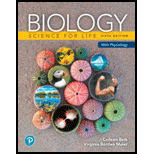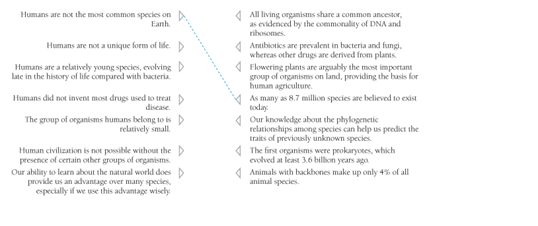
Pearson eText Biology: Science for Life with Physiology -- Instant Access (Pearson+)
6th Edition
ISBN: 9780135214114
Author: Colleen Belk, Virginia Maier
Publisher: PEARSON+
expand_more
expand_more
format_list_bulleted
Concept explainers
Textbook Question
Chapter 14, Problem 1MTC
The science that you learned in this chapter has helped you better understand the real-world example used throughout this discussion. Draw a line from the statement on the left to the science that supports it on the right.

Answers to Got It? Visualize This, Working with Data, Sounds Right, But Is It?, Show You Know, and Chapter Review questions can be found in the Answers section at the back of the book.
Expert Solution & Answer
Trending nowThis is a popular solution!

Students have asked these similar questions
Please help me with this question ?
State the similarity and difference between biology and philosophy. Express your answer in not more than five sentences.
Narrative of your experiences of research in daily life.
Kindly answer please. Badly needed
List the important ideas in the video.
https://youtu.be/Y-a9Vcg7_Rs
Chapter 14 Solutions
Pearson eText Biology: Science for Life with Physiology -- Instant Access (Pearson+)
Ch. 14 - How many different species have been identified by...Ch. 14 - Add labels to the figure that follows, which...Ch. 14 - How are hypotheses about the evolutionary...Ch. 14 - Which of the following kingdoms or domains is a...Ch. 14 - Comparisons of ribosomal RNA among many different...Ch. 14 - On examining cells under a microscope, you notice...Ch. 14 - The mitochondria in a eukaryotic cell ___________....Ch. 14 - Prob. 8LTBCh. 14 - Prob. 9LTBCh. 14 - Phylogenies are created based on the principle...
Ch. 14 - Unless handled properly by living systems, oxygen...Ch. 14 - Imagine you have found an organism that has never...Ch. 14 - Support for the endosymbiotic theory for the...Ch. 14 - Research a species of plant, animal, fungi, or...Ch. 14 - Scientists initially rejected the endosymbiotic...Ch. 14 - The science that you learned in this chapter has...
Knowledge Booster
Learn more about
Need a deep-dive on the concept behind this application? Look no further. Learn more about this topic, biology and related others by exploring similar questions and additional content below.Similar questions
- The disease I have chosen to research is Parkinson's disease. find three (3) citations that could be used for this topic. Annotate each of these citations with a separate 5-sentence paragraph, including the following information: Description of the source and author: Are they reliable and valid? [1 sentence] Description of findings that may be important to your project. [2–3 sentences] Include the reason why you chose the source. How will it support your project? [1 sentence] The first 3 were already done I need another 3 citations please!arrow_forwardThe disease I have chosen to research is Parkinson's disease. find three (3) citations that could be used for this topic. Annotate each of these citations with a separate 5-sentence paragraph, including the following information: Description of the source and author: Are they reliable and valid? [1 sentence] Description of findings that may be important to your project. [2–3 sentences] Include the reason why you chose the source. How will it support your project? [1 sentence]arrow_forwardFor this assignment, you will work in groups of threes to provide an oral critique of a student’s topic-to-sentence outline and a body paragraph, create a revised formal topic-to-sentence outline and a mini essay [containing an introductory paragraph, 1 body paragraph and a concluding paragraph], followed by a Works Cited list, and an annotated bibliography of one source used in the mini essay. Your presentation and mini essay must be based on the following.ContextKaleb was tasked to write a mini essay on one of the following topics:a. Discuss three elements of poor mental health.ORb. What are three groups of diseases among humans?arrow_forward
- What is critical thinking, and why is it important? For the toolbar, press ALT+F10 (PC) or ALT+FN+F10 (Mac). BI U S Paragraph Arialarrow_forwardPartway through my first semester in college, I tried drawing and labeling pictures as a study tool, and my grades on multiple choice exams improved. I decided to design an experiment to see if this same trick works more generally. I split up students into two groups in my LIFE 102 class: Group A were given the PowerPoint slides for lecture and asked to review the material for their weekly quiz based on the lecture notes only. Group B were given the same PowerPoint slides during lecture and asked to draw the content visible on the slides during lecture in their notebooks. I asked students to share their notes with me so I could confirm which students drew their own pictures and which students used lecture notes only. Then, I evaluated their quiz grades. Write an alternative hypothesis and a null hypothesis for my experiment. Then write a prediction for each of these hypotheses. Label them clearly, as in this structure: Alternative Hypothesis: [general statement of a phenomenon…arrow_forwardCan someone please help me with these questions?arrow_forward
- Please assist me because I'm not sure I understand. What are the excellent sentences in this response, and what are the logical flaws, content errors, or outright stupid comments? What are the main differences between inductive and deductive reasoning in the scientific method? Inductive reasoning and deductive reasoning are both methods of reasoning, but they are used for different purposes and have different characteristics. Inductive reasoning is a method of reasoning in which a general principle or conclusion is drawn from specific observations or instances. It is often used in the scientific method to form hypotheses and make predictions. For example, a scientist may observe that a certain type of plant always grows well in a certain type of soil, and from this observation, they may form a hypothesis that all plants will grow well in that soil. Inductive reasoning is considered less certain than deductive reasoning because it involves making generalizations based on limited…arrow_forwardHelp me on this tutor Here's reference link : https://drive.google.com/file/d/1fAKXhYuHBc-9OU68hrY821b9CHk2yffC/view?usp=drivesdkarrow_forwardestions 23 is an open-response question. BE SURE TO ANSWERAND LABEL ALL PARTS OF THE QUESTION. Show all your work (diagrams, tables, or computations) in your Student Answer Booklet. If you do the work in your head, explain in writing how you did the work. Write your answer to question 23 in the space provided in your Student Answer Booklet. 23 A food web is shown below. Hawk Bat Raccoon Dragonfly Owl + Mouse Beetle An organism in the food web is labeled X. a. Identify and describe the ecological role of organism X in the food web. b. Identify the organism in the food web whose population size would likely increase the most if the bat became extinct. Explain your answer. There are many types of relationships between organisms, including competitive and predator-prey relationships. c. Identify two organisms in the food web that have a competitive relationship. Explain your answer. d. Identify two organisms in the food web that have a predator-prey relationship. Explain your answer. 269arrow_forward
- Provide an answer in number 1 to 5. Understand the direction in the picture below. It’s not incomplete. No need to explain each answer. Provide a correct letter as correct answer. Thank you in advance.arrow_forwardI am having trouble conducting a search for articles for this PICOT question. I would like to use the following databases CINAHL, Medline, Nursing & Allied Health whenever I use the key term/key concepts using boolean term I get nothing.arrow_forward-YOU MUST ANSWER THE PROBLEM IN FACT OR BLUFF GENERAL DIRECTION: Write "Fact" if the statement is correct and "Bluff" if otherwise. - IN FACT OR BLUFF! YOU MUST ANSWER 1 TO 15. - NOTE THIS: NO NEED TO EXPLAIN EACH PROBLEM. JUST ANSWER IF IT WAS FACT OR BLUFF. -PLEASE FOLLOW THE DIRECTION -PLEASE HELP ME OUT THANK YOU SO MUCH IN ADVANCE.arrow_forward
arrow_back_ios
SEE MORE QUESTIONS
arrow_forward_ios
Recommended textbooks for you
- Case Studies In Health Information ManagementBiologyISBN:9781337676908Author:SCHNERINGPublisher:CengageEssentials Health Info Management Principles/Prac...Health & NutritionISBN:9780357191651Author:BowiePublisher:Cengage
 Comprehensive Medical Assisting: Administrative a...NursingISBN:9781305964792Author:Wilburta Q. Lindh, Carol D. Tamparo, Barbara M. Dahl, Julie Morris, Cindy CorreaPublisher:Cengage Learning
Comprehensive Medical Assisting: Administrative a...NursingISBN:9781305964792Author:Wilburta Q. Lindh, Carol D. Tamparo, Barbara M. Dahl, Julie Morris, Cindy CorreaPublisher:Cengage Learning Human Heredity: Principles and Issues (MindTap Co...BiologyISBN:9781305251052Author:Michael CummingsPublisher:Cengage Learning
Human Heredity: Principles and Issues (MindTap Co...BiologyISBN:9781305251052Author:Michael CummingsPublisher:Cengage Learning


Case Studies In Health Information Management
Biology
ISBN:9781337676908
Author:SCHNERING
Publisher:Cengage

Essentials Health Info Management Principles/Prac...
Health & Nutrition
ISBN:9780357191651
Author:Bowie
Publisher:Cengage


Comprehensive Medical Assisting: Administrative a...
Nursing
ISBN:9781305964792
Author:Wilburta Q. Lindh, Carol D. Tamparo, Barbara M. Dahl, Julie Morris, Cindy Correa
Publisher:Cengage Learning

Human Heredity: Principles and Issues (MindTap Co...
Biology
ISBN:9781305251052
Author:Michael Cummings
Publisher:Cengage Learning
Information Storage and the Brain: Learning and Memory; Author: Professor Dave Explains;https://www.youtube.com/watch?v=PQDiUKwXLVI;License: Standard youtube license